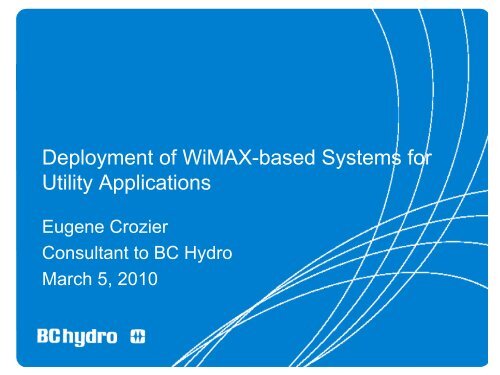Slides - ICICS
Slides - ICICS
Slides - ICICS
- No tags were found...
Create successful ePaper yourself
Turn your PDF publications into a flip-book with our unique Google optimized e-Paper software.
Deployment of WiMAX-based Systems forUtility ApplicationsEugene CrozierConsultant to BC HydroMarch 5, 2010
Utility Wireless Applications• Support the management of power delivery system– Monitoring, protection and control1.8 GHzAirlink2
Utility Wireless Application Needs• Utilities need ubiquitous overage over their infrastructure areas.– Power generation plants and substations are not always in areas with high population.– Distribution grids don’t always follow main traffic routes.– Wireless provides cost effective coverage, complimentary to wireline.• Reliability is non-negotiable.– Regardless of the environment, society expects utilities to work.– Infrastructure management needs the ability to monitor, control and forecast the usage.– The communications network needs to be stable and predictable.• Security– Must be able to trust the network.– No network disruption.• Integration and support of the existing infrastructure.– Utilities have a variety of different and legacy technologies which continue to be reliable.– Upgrades and changes have to be evolutionary not revolutionary• Support of smart metering.– Enable more efficient use of energy resources.• Mainly fixed and nomadic modes of operation.• The majority of the information is from the distribution, so UL biased.• Corrective action needs to be fast to minimise any shutdown.– Low latency.– Systems need to work when cutoff from the main network.3
Technology Options• Proprietary System.– Can be customised to suit the application needs.– The deployed technology has to have a support lifetime of greater than 10 years.– Single sourced can be a risk.• Telco.– Telco’s business model doesn’t fit with the utilities requirement for “force majeure”– The low latency requirement isn’t always possible.– Utilities want network stability and changes to be on their own business needs.– Telco’s won’t accept liability for cyber security.• Standards based solution.– Multiple equipment vendor support– Tend to subject to peer reviews.– Iterative development, based on industry needs.– WiMAX• Based on IEEE 802.16.• Requirements developed initially by players and manufacturers from the fixed wireless industry.• OFDM, supporting fixed and nomadic operation.• OFDMA, an enhancement of OFDM, having multiple antenna support, better airlink performanceand mobility.– LTE• Developed by the operators and associated manufacturers from the 3G industry.• Optimized for mobility.• Suited for large subscriber count deployments.4
WiMAX Features• Based on OFDM• Why OFDM– Desire for higher capacity keeps increasing.– Pushing wider bandwidths in real life environments.– Fading and distance distort the amplitude.– Buildings and obstructions cause reflections that distort the phase.– With wideband RF signals correcting both the amplitude and phasedistortions in a wideband signal is a challenge for the receiver.– OFDM divides the information into separate and smaller bitstreams, theidea being that with narrow band signals it is easier to correct than withwideband signals. So the processing burden is shared with thetransmitter.– The multiple narrowband signal can be corrected both in amplitude andphase based on estimates made of the channel environment.5
WiMAX OFDM OFDMA• Main aspects for the utilities.– WiMAX OFDM is derived from IEEE 802.16-2004, sometimes known as16d.– WiMAX OFDM supports;• NLOS.• Operating modes.– Fixed.– Nomadic.– Limited portable operation to 5 km/h– WiMAX OFDMA is derived from IEEE 802.16e-2005, sometimes knownas 16e. OFDM and OFDMA are now combined into IEEE 802.16-2009.– WiMAX OFDMA supports;• WiMAX OFDM feature and mobility up to 120 km/h, through the use of multiple pilots• Enhanced profile B for fixed and nomadic deployments• Better system gain.• Multiple antennas.• Better security as a consequence of supporting mobility.• More vendor support.– WiMAX OFDM is not compatible with WiMAX OFDMA.• Changing from one to the other is a major infrastructure change.6
WiMAX OFDM Main features• Stable technology.– Future standards development unlikely, hence stable.• Relatively low cost.– CPE devices are simple and low cost. Mostly outdoor, limited indoordevices.• Ideal for fixed deployment.– The tool kit of features such as the NLOS ability, adaptive modulation anderror correction, are used to stabilize the airlink.• Simple infrastructure requirements.– Each base station can be standalone.• Ideal for simple private networks.– Can operate without centralized features such as AAA and billing.• Good interoperability between certified equipment.– Because of the limited options each CPE tested against 3 base stations.• Higher capacity than OFDMA for fixed deployments.– Less overhead for mobility.7
WiMAX OFDMA Main features• Growing technology.– Ongoing technology development, to 802.16m and IMT Advanced.• Rich selection of devices.– Fixed, nomadic and mobile devices are and being certified mostly at 2.5GHz and to a lesser extent at 3.5 GHz.• Accepted by ITU as a 4G technology.– IMT 2000 technology– On par with LTE as a technology.• Supports MIMO.– Matrix A gives better availability• High performance airlink, leading to lower whole network costs.– Frequency re-use and multiple antenna techniques lead to less sitesneeded and more efficient use of spectrum resources.• Advanced end to end network features and support.– Support for enterprise features such as VLANs.8
1.8 GHz Licensed Utility Spectrum• Canadian Regulatory Requirements– Technical requirements in SRSP 301.7 Issue 2 June 2009• Assignment is 1800-1830 MHz for a specific use, “operation,maintenance and management of the electric supply”.• Limitation: Licensee not to exceed 20 MHz unless technicaljustification for additional bandwidth.– Hence TDD• Fixed and Fixed Transportable operation.• Support for both LOS and NLOS is needed.• Licence-Exempt Spectrum– Doesn’t provide the range and reliability available from licensed spectrum.– Licence-exempt operations are subject to interference and congestionfrom other incompatible users.– Licence-exempt operations are primarily used for non-critical/redundantcommunications (e.g., meter reading) that need high capacityconnectivity.9
WiMAX 1.8 GHz deployment parameters• RF deployment.– Support of 1.8 GHz, using the main features of equipment certified at 2.5and 3.5 GHz, initially using 5 MHz channels– Generally for TDD, GPS is used, however to avoid a single point offailure, standby alternatives to be considered.– Use as much as possible the existing sites.– Maximum 25 km cell radius, may need to allow up to 40 km with a smallernumber of SSs.– Within the network performance criteria, availability is the most important,so for OFDMA, MIMO matrix A is desired and redundancy for OFDM.– How much multipath exists, to be investigated.– Latency requirements of 30 ms, (CPE to CPE).• Support for single hop repeater stations for remote sites.– We anticipate about 80% of the base station sites will need a repeater.• Typically subscriber site.– Outdoor unit at a substation, a branch office, or attached to a street sidepole.– Self install and use.– Have redundancy or diversity options.10
UBC Channel Modeling• Previous studies on fading in fixed wireless channelsbetween 200 MHz and 2 GHz.• Plan to build on this and similar studies to assist withthe understanding of WiMAX equipment performanceat 1.8 GHz.• Currently establishing a test bed within the RadioScience Lab.• The intention is use WiMAX conformance parametersas a baseline to assess the bench performance ofequipment at 1.8 GHz compared to field tests.• BC Hydro also working with other institutions to assessthe IP performance as applicable to utility applications.11
Many thanks toThe UBC Radio Science Lab (and Western EconomicDiversification Canada) for access to:– Research results– Facilities– Equipment12







